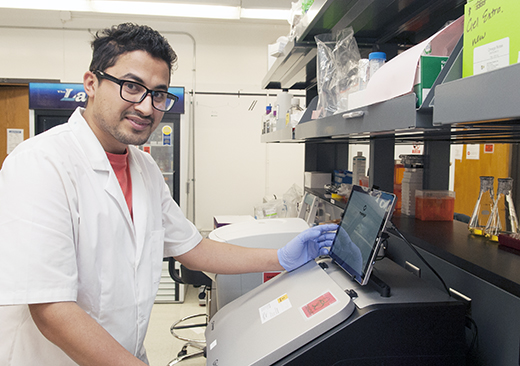Doctoral student's research on 'good' virus may one day help with treating bad diseases
Tuesday, March 28, 2017

Anil Pant, a doctoral student in biology, has made strides in understanding vaccinia, a virus that could lead to therapeutic and preventative vaccines. | Download this photo.
MANHATTAN — A Kansas State University doctoral student in biology has uncovered some key findings about vaccinia, a virus that can take on other viruses' traits. Vaccinia could become a tool for vaccine development.
"Many people think all viruses are bad, but vaccinia can be a 'good' virus that can be developed into treatments for dreadful diseases," said Anil Pant, Nepal, whose research has been funded by the National Institutes of Health and Kansas State University's Johnson Cancer Research Center and Division of Biology.
While most viruses crave glucose, which is a simple sugar, vaccinia feeds on glutamine, an amino acid that is one of protein's building blocks. Pant is studying the underlying mechanisms of this unusual eating habit of vaccinia because of irregularities in how vaccinia communicates with cells.
"Knowing what vaccinia needs can help us develop more efficient vaccines for treating diseases," said Pant, who recently earned second place for explaining his research at Kansas State University's Three Minute Thesis Competition. "Knowing what vaccinia consumes and why helps us to intervene with the nutrients it consumes so that we can modify the vaccinia vaccine vector and combine it with medications against infectious diseases."
Under the guidance of Zhilong Yang, assistant professor of biology, Pant put vaccinia in specific conditions to watch what types of nutrients and amino acids it chose to feed on. If glutamine, which it favors, is not present, vaccinia will feed on another metabolite, but it will lose some of its strength.
Vaccinia was used as the vaccine against smallpox, which was eradicated in 1980, and it is currently used as a vaccine in some people. Yang said it also could aid in developing preventative or therapeutic vaccines against the Zika virus, influenza and tuberculosis, as well as deadly viruses that could be used in bioterrorism. Also, it could be developed into therapy for many cancers. Pant said scientists are using modified vaccinia to develop vaccines that could block the replication of HIV.
Pant obtained his bachelor's and master's degrees in microbiology from Tribhuvan University in Nepal.
